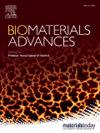多孔增材制造镁基合金在骨科应用中的生物功能化研究进展。
IF 5.5
2区 医学
Q2 MATERIALS SCIENCE, BIOMATERIALS
Materials Science & Engineering C-Materials for Biological Applications
Pub Date : 2025-01-02
DOI:10.1016/j.bioadv.2024.214170
引用次数: 0
摘要
镁合金由于其独特的材料特性,作为一种生物可降解的骨修复材料,受到了广泛的关注。最近,镁和镁基合金已被用作骨组织工程应用的承重金属支架,在该领域提供了很好的机会。镁基合金的力学性能和相对密度与天然人体骨组织非常接近,从而降低了应力屏蔽效应的风险。此外,镁基合金固有的生物可降解性消除了第二次手术移除植入物的必要性,而传统的不可降解植入物通常需要进行第二次手术。然而,一个值得注意的挑战仍然是如何在生理环境中控制镁和镁基合金的高腐蚀速率,以确保它们满足必要的功能要求。因此,全面分析和了解镁和镁基合金的腐蚀行为,并优化其表面性能,对确保成功的临床应用具有关键意义。Mg和Mg基合金植入物的个性化3D打印代表了一种范式转变,提供了大量的优势,其中最重要的是可降解的多孔结构促进了骨愈合过程,有利于骨向内生长。此外,镁基植入物表面功能化技术的出现将金属固有的机械和降解特性与这些涂层提供的增强的生物功能相结合。这种协同作用为使用镁基种植体作为临时矫形和牙科解决方案提供了一个非常有前途的途径。这篇全面的综述详细分析了合金元素、增材制造工艺、晶格结构和生物功能涂层的最新进展,以定制镁基骨科植入物的耐腐蚀性、机械性能和生物相容性。本文章由计算机程序翻译,如有差异,请以英文原文为准。

Biofunctionalisation of porous additively manufactured magnesium-based alloys for Orthopaedic applications: A review
Magnesium (Mg) alloys have gained significant attention as a desirable choice of biodegradable implant for use in bone repair applications, largely owing to their unique material properties. More recently, Mg and Mg-based alloys have been used as load-bearing metallic scaffolds for bone tissue engineering applications, offering promising opportunities in the field. The mechanical properties and relative density of Mg-based alloys closely approximate those of natural human bone tissue, thereby mitigating the risk of stress-shielding effects. Furthermore, the inherent biodegradability of Mg-based alloys eliminates the necessity for a second surgical procedure for the removal of the implant, a frequent requirement with conventional non-degradable implants. However, a notable challenge remains in managing the high corrosion rate of Mg and Mg-based alloys within physiological environments to ensure that they meet the necessary functional requirements. Consequently, a comprehensive analysis and understanding of the corrosion behaviour of Mg and Mg-based alloys, coupled with optimisation of their surface properties, assume pivotal significance to ensure successful clinical application. The personalized 3D printing of Mg and Mg-based alloy implants represents a paradigm shift, offering a plethora of advantages, foremost among them being the enhancement of the bone healing process facilitated by the degradable porous structure conducive to bone ingrowth. Also, the emergence of surface functionalisation techniques for Mg-based implants amalgamates the mechanical and degradation properties inherent to metals with the enhanced biofunctionality offered by these coatings. This synergy presents a highly promising avenue for using Mg-based implants as temporary orthopaedic and dental solutions. This comprehensive review provides a detailed analysis of recent advancements encompassing alloying elements, additive manufacturing processes, lattice structures and biofunctionalised coatings to tailor the corrosion resistance, mechanical properties and biocompatibility of Mg-based orthopaedic implants.
求助全文
通过发布文献求助,成功后即可免费获取论文全文。
去求助
来源期刊
CiteScore
17.80
自引率
0.00%
发文量
501
审稿时长
27 days
期刊介绍:
Biomaterials Advances, previously known as Materials Science and Engineering: C-Materials for Biological Applications (P-ISSN: 0928-4931, E-ISSN: 1873-0191). Includes topics at the interface of the biomedical sciences and materials engineering. These topics include:
• Bioinspired and biomimetic materials for medical applications
• Materials of biological origin for medical applications
• Materials for "active" medical applications
• Self-assembling and self-healing materials for medical applications
• "Smart" (i.e., stimulus-response) materials for medical applications
• Ceramic, metallic, polymeric, and composite materials for medical applications
• Materials for in vivo sensing
• Materials for in vivo imaging
• Materials for delivery of pharmacologic agents and vaccines
• Novel approaches for characterizing and modeling materials for medical applications
Manuscripts on biological topics without a materials science component, or manuscripts on materials science without biological applications, will not be considered for publication in Materials Science and Engineering C. New submissions are first assessed for language, scope and originality (plagiarism check) and can be desk rejected before review if they need English language improvements, are out of scope or present excessive duplication with published sources.
Biomaterials Advances sits within Elsevier''s biomaterials science portfolio alongside Biomaterials, Materials Today Bio and Biomaterials and Biosystems. As part of the broader Materials Today family, Biomaterials Advances offers authors rigorous peer review, rapid decisions, and high visibility. We look forward to receiving your submissions!

 求助内容:
求助内容: 应助结果提醒方式:
应助结果提醒方式:


